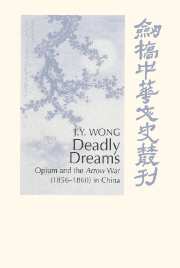Book contents
- Frontmatter
- Contents
- List of Tables
- List of Figures
- Poem by the late Mr Qin Esheng
- Foreword by Professor Wang Gungwu
- Foreword by Professor C. A. Bayly
- Preface
- Part I The confusion of imperialism
- Part II The pretext for imperialism
- Part III The personalities of imperialism
- Part IV The rhetoric of imperialism
- Part V The mechanics of imperialism
- Part VI The economics of imperialism
- 14 Anglo-Chinese trade: The Chinese should buy more
- 15 China's maritime trade: The Chinese could buy more
- 16 The problem of India: The Chinese should and could buy more
- 17 The balance sheet: The Chinese are now buying more
- Part VII The dynamics of imperialism
- Chronology of major events
- Word list
- Abbreviations
- Bibliography
- Index
14 - Anglo-Chinese trade: The Chinese should buy more
Published online by Cambridge University Press: 29 September 2009
- Frontmatter
- Contents
- List of Tables
- List of Figures
- Poem by the late Mr Qin Esheng
- Foreword by Professor Wang Gungwu
- Foreword by Professor C. A. Bayly
- Preface
- Part I The confusion of imperialism
- Part II The pretext for imperialism
- Part III The personalities of imperialism
- Part IV The rhetoric of imperialism
- Part V The mechanics of imperialism
- Part VI The economics of imperialism
- 14 Anglo-Chinese trade: The Chinese should buy more
- 15 China's maritime trade: The Chinese could buy more
- 16 The problem of India: The Chinese should and could buy more
- 17 The balance sheet: The Chinese are now buying more
- Part VII The dynamics of imperialism
- Chronology of major events
- Word list
- Abbreviations
- Bibliography
- Index
Summary
Anglo-Chinese trade in this period has never been systematically quantified; nearly all discussion of the origins of the Arrow War has revolved around the personalities. References to trade have always been very general. This chapter fills that gap by collecting the annual statistics prepared by the Board of Trade in London and putting them into tables covering several decades. Such tables generally go back to when the statistics on certain topics were first made available and sometimes extend for a few years beyond the Arrow War in order to reveal the long-term trends. The reader is reminded that we are dealing with perceptions rather than reality. Hence, the ‘official value’ and the later ‘computed real value’, as well as the ‘declared value’, are all transcribed from the Parliamentary Papers without converting the official value to real value to make it comparable with the rest.
I. Export of British manufactures to China
Let us begin with the export of British manufactures to China. This was, of course, an overriding consideration for British policy makers. The two major items of manufacture exported to China and Hong Kong were cottons and woollens. The value –and here I use the original figures as found in the Parliamentary Papers rather than those I have truncated in Table 14.1 –of cottons exported to China and Hong Kong rose from £67,303 in 1827 t o £2,090,158 in 1858.
- Type
- Chapter
- Information
- Deadly DreamsOpium and the Arrow War (1856–1860) in China, pp. 333 - 364Publisher: Cambridge University PressPrint publication year: 1998



